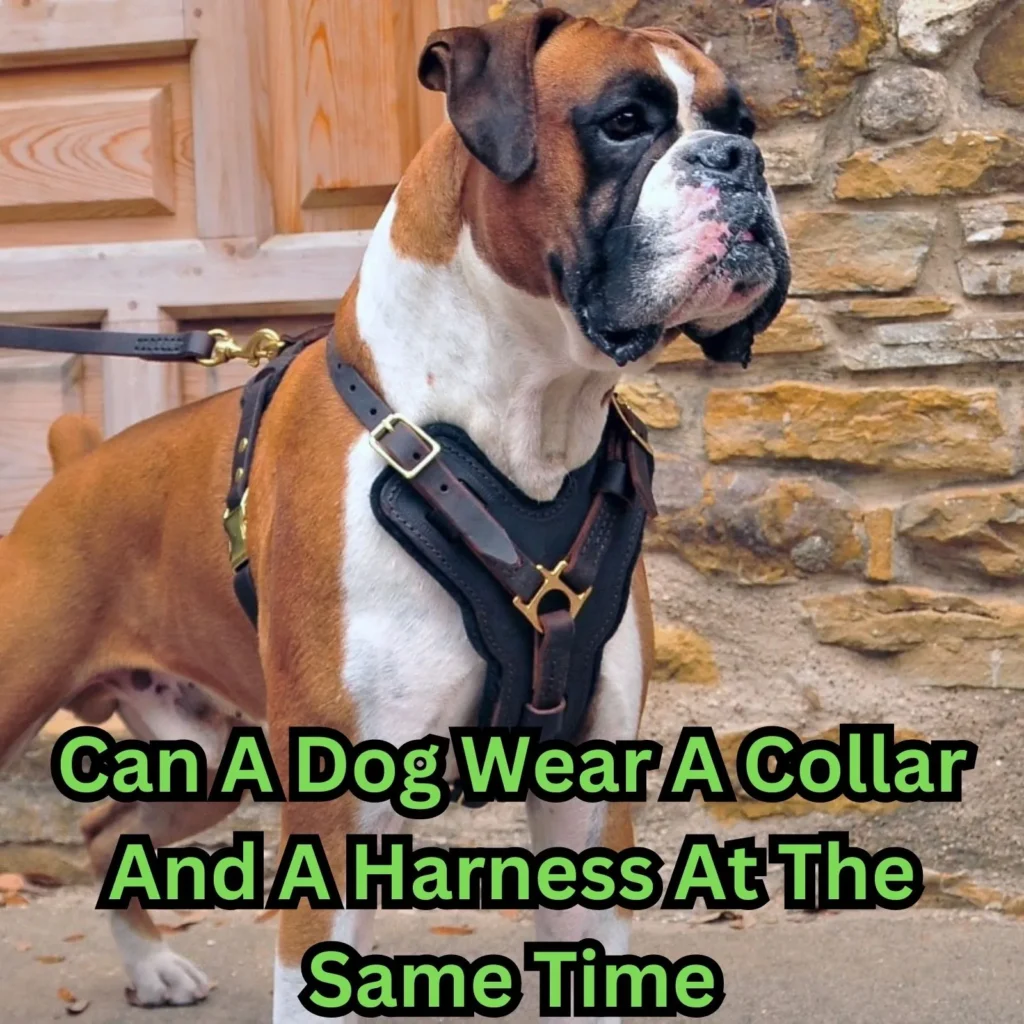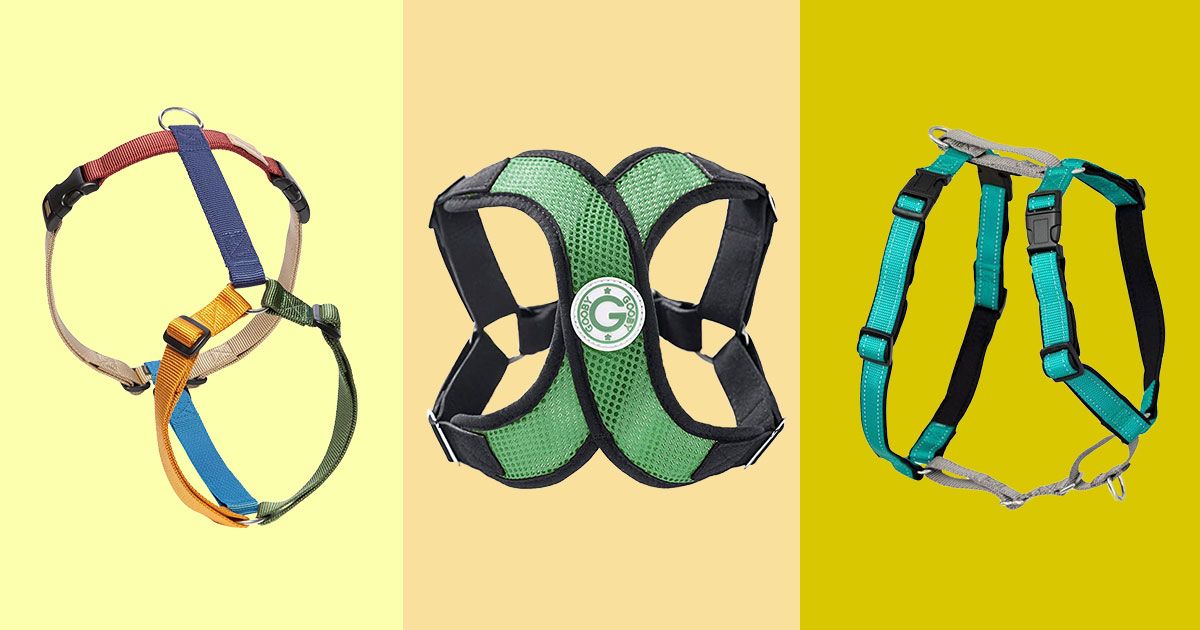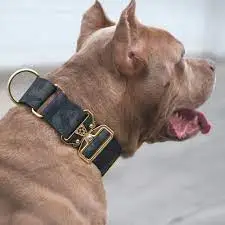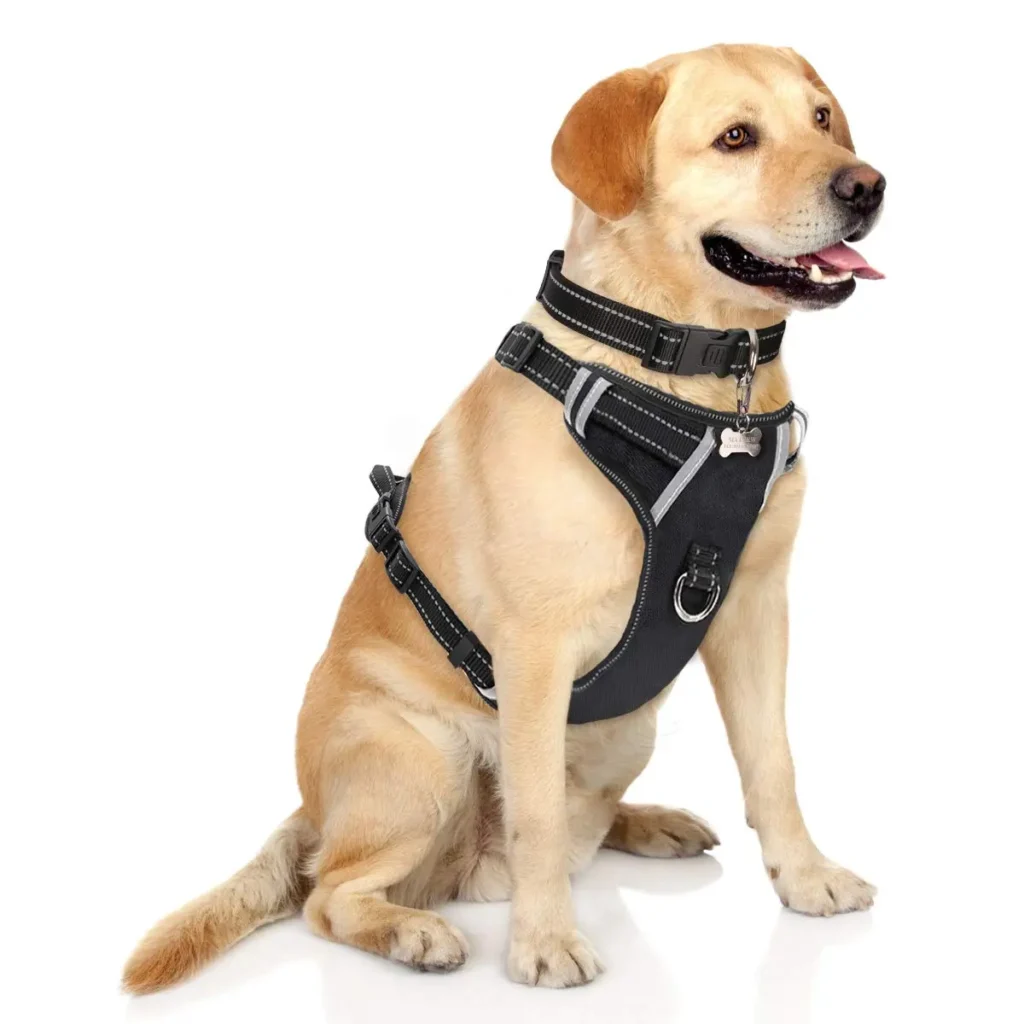
Absolutely, your canine companion can comfortably wear both a collar and a harness concurrently, fostering both safety and control during your delightful dog walks. Sure, here we are going to discuss if a dog can wear both a collar and a harness at the same time. This topic is quite relevant to every dog owner thinking about how to ensure the comfort as well as safety of their canine friends during outings.
| Dog Collars | Dog Harnesses |
|---|---|
| They are primary identifiers for dogs and hold the tags. | They are designed to distribute pressure over your dog’s body and reduce strain on their neck. |
| Recommended for trained dogs that walk well on a leash. | Great for dogs that pull and those with upper respiratory diseases or throat issues, such as Pugs and Bulldogs. |
| Some collars have special features such as being breakaway or light-up for additional safety. | Harnesses reduce risk of injury for powerful and energetic dogs. They also give better control over your pet’s direction. |
| Not an ideal option for dogs prone to tracheal damage (aka windpipe damage). | Not all harnesses suit every breed; selecting the right size and style based on breed and functionality matters. |
From this comparison table, you can see why some dog owners may opt for using both a collar and a harness simultaneously. Collars carry identification tags which are crucial if your dog ever wanders off or gets lost source: American Kennel Club. The collar acts as your pet’s personal ID. On the other hand, harnesses provide better control especially for robust and high-energy dogs who tend to pull on the leash; it distributes pressure evenly over the body, reducing the risk of injuries.
A quote by Alexander Pope, “Histories are more full of examples of the fidelity of dogs than of friends,” underlines the importance of safeguarding our beloved four-legged companions. It makes sense to utilize both these tools together to enhance our pets’ safety further.
To summarize then, it’s not only possible but also sometimes advantageous for a dog to wear a collar and a harness at the same time. However, comfort must be the priority. Ensure that neither the collar nor the harness is too tight to avoid discomfort or potential injury. Always look for signs that your dog might be uncomfortable, such as changes in behavior or trouble walking. With the proper fit and attention to their comfort, this combination can work very well to keep your dog safe and secure.
Understanding the Benefits of Using Both Collar and Harness
:strip_icc()/GettyImages-1280441727-6e25236909254165b4c2449fd8e22f58.jpg)
Every dog owner often grapples with the ideal choice between a harness and collar for their beloved pet, but what most do not realize is that it’s entirely possible and sometimes even beneficial to use both simultaneously. A common concern is, “Can a Dog Wear a Collar And A Harness At The Same Time?” The answer is an enthusiastic yes!
The Advantages of Using Both a Collar and a Harness
- Enhanced Security: With both a collar and a harness on your dog, you’re effectively doubling up security and control during walks. If your fur-buddy is the adventurous, explorer type who forgets everything once they sniff out something interesting, having two places to hold onto reduces the chances of them running off.
- Dual Training Tools: The combined use of collars and harnesses can serve as effective training aids. For example, you could use the collar for leash manners and the harness for recall training or vice versa. You can choose which intervention works best for your dog’s specific needs.
- Distribution of Pressure: Harnesses distribute pressure across a larger area of the dog’s body than collars, reducing the likelihood of injury. While wearing both, the pressure exerted when the leash is pulled gets distributed across the neck (in case of collar) and chest or back (in case of harness), minimizing possibility of injuries.
| Type | Advantages |
| Harness | Pressure distribution, increased control over pulling dogs, better for brachycephalic (flat-faced) breeds |
| Collar | Easier for dogs to wear and get used to, useful for ID tags, easier to clean |
| Both | Combines advantages of both; greater control and oversight, effective training aid, reduced pressure on any single region |
Simultaneously using a dog collar and harness offers more benefits than just one or the other. But remember – the key lies in correctly fitting these articles and selecting the right variants according to your dog’s demeanor, size, breed, and sensitivity.
As Roger Caras truely stated, “Dogs are not our whole life, but they make our lives whole.” Thus, ensuring their comfort, safety while enabling better control for you should be the objective while choosing between a collar, a harness or both!
You can consult with your local trainer or veterinarian about whether your pet can benefit from using both, and if so, how to correctly fit a collar and harness.
Examining Possible Dog Risks: Overuse of Collars and Harnesses Simultaneously

To answer your query, yes, a dog can wear both a collar and harness at the same time. However, it’s important to evaluate and understand the possible risks associated with their overuse, as each one serves a specific purpose. Let’s dive deeper into this:
What Is The Purpose of Each?
A collar is primarily used for holding identification tags and licenses. It’s frequently used for corrective training too.
On the other hand, a harness is specifically designed for walking your dog. It provides better control and reduces strain on the neck, especially for smaller breeds and puppies.
Risk of Overuse
Using a collar and harness at the same time has its drawbacks:
- Ineffective Training: If you’re using both tools for behavioral correction, it may confuse your dog and affect the efficacy of your training sessions.
- Discomfort or Injury: Overuse can lead to discomfort due to rubbing and chafing. In worst cases, it could potentially lead to injuries due to excessive restraining.
- Potential Choking Hazard: A loose harness can get caught on something and pose a choking hazard. Similarly, a very tightened collar may also instigate choking issues.
Guidelines For Using Both
If you decide to use both, here are some guidelines you might find helpful:
- Correct Sizing: Ensure both the collar and harness fit properly. They should be tight enough to stay on but loose enough for comfort.
- Awareness of Its Purpose: Use the tools for their intended purposes. The collar should primarily be for identification and the harness for walking or controlling your dog.
- Regular Checks: Regularly check for any signs of discomfort or injury caused by overuse or improper use of these items.
Typically, many dog owners prefer to use both a collar and a harness for increased safety during walks. A quote from Roger Caras nicely sums up our responsibility: “Dogs are not our whole life, but they make our lives whole.” As part of our commitment to ensuring our dogs’ wellbeing, it’s imperatively vital that we pay attention to how we’re using such tools for them. After all, their comfort and safety should always take precedence.
Harness and Collar Combinations: Choosing What Works Best for Your Dog

Choosing an optimal setup involving collar and harness for your dog can often feel like a complex puzzle. But, I’m here to help you navigate through it with ease. The question perhaps on many pet owners’ minds: “Can my precious canine wear a collar and a harness at the same time?” The long and short of it: Yes, your four-legged friend can certainly wear both simultaneously. However, understanding when and why to use this combination is key.
Firstly, let’s answer the ‘why’. Dog collars are practical for attaching identification tags as well as facilitating leash walking, while some collars like martingale are designed specifically for dogs who might slip out their collars due to neck-to-head ratio. Harnesses, on the other hand, are favored for reasons such engaging in outdoor adventures, or having control over dogs who pull during walks. Using both a collar and a harness can enhance control and security, moreover, benefitting dogs prone to escaping or those with health issues that may prohibit exclusive collar or harness usage.
“The best therapist has fur and four legs.” – Unknown
The strength behind this quote lies in our collective love for our furry friends. Now, let me guide you on the different mix-and-match methods that could work best for your cuddle buddy.
| Collar and Harness Combination | Utility And Benefits |
|---|---|
| ID Collar + Front-Clip Harness | Provides maximum control over pulling and best used for leash walking training. |
| ID collar + Back-Clip Harness | Ideal for calm dogs who don’t pull during walks. Reduces strain on neck and spreads pressure over a larger area of the body. |
| Martingale Collar + Front-Clip/Back-Clip Harness | This combo provides added security for dogs who could escape from their collars. The harness still ensures reduced strain on the neck. |
Deciding between these combinations

Deciding between these combinations should cater to your dog’s behavior, size, breed & health conditions. Every dog is unique and their needs vary widely so when choosing ‘collar-only’, ‘harness-only’, or a duo of both, remember, comfort is paramount.
Yes, wearing a collar along with a harness can cause hair loss or skin irritation if not fitted properly. This can be prevented by ensuring neither the collar nor harness is too tight or leaves too much room for wriggling out. Regular checks and adjustments are necessary to maintain optimal benefits of this combination. Choosing padded, adjustable, and breathable materials can also greatly enhance comfort.
Finally, never leave the collar or harness on your dog while unattended for extended periods of time. Even the most secure and comfortable gear can pose hazards such as strangulation or chafing if left unchecked.
To expand your understanding further on which combination works best and how it differs with breeds, activities, or conditions, consider checking out informative resources such as this article by American Kennel Club. Always consult with your vet or a reputable dog trainer for personalized advice.
After a comprehensive analysis on ‘Can a Dog Wear a Collar and a Harness at the Same Time?’ we can affirm that, yes, dogs can wear both a collar and a harness simultaneously without posing any significant health risks. However, this combination should be used thoughtfully with the dog’s comfort and safety in mind.
- Proper Fit: Regardless of your decision to use just a collar, just a harness, or both, make sure that they are appropriately fitted. Anything overly tight can restrict movement and anything too loose can increase the risk of slipping out.
- Varying Uses: This setup may serve several purposes like the collar for ID tags and the harness primarily for leash attachment, giving you more flexibility and control during walks.
- Training Benefits: If used with proper training techniques, having a collar along with a harness could be significantly beneficial in curbing unwanted behaviors.
However, it comes down to your canine’s physical condition, behavior, breed, and size among other factors. As noted by The Bark, “Depending on the individual dog, one might find a specific collar or harness is better suited to their needs.”
Ultimately, “Dogs do speak…but only to those who know how to listen,” as Orhan Pamuk once said. Listening in this context means understanding your dog’s comfort, preferences, and needs regarding whether it would prefer a collar, a harness, or both simultaneously.

| Consideration | Specific Tips |
|---|---|
| Fit and Comfort | Ensure that your dog’s collar or harness has an appropriate fit which neither restricts its movement nor does it hangs too loose. |
| ID Tags | A collar can still serve as the primary holder for ID tags even if a harness is also worn. |
| Leash Attachment | Walks may be more comfortable for both you and your dog if the leash is attached to a harness rather than a collar, particularly for dogs prone to pulling. |
| Training | a collar alongside a harness could help instill better walking habits in your beloved pooch from discouraging pulling tendencies to promoting controlled movements. |
All these considerations enable you to make an informed decision about combining collars and harnesses for your furry friend. Always stay observant to ensure they feel comfortable and safe with whichever options you pick.